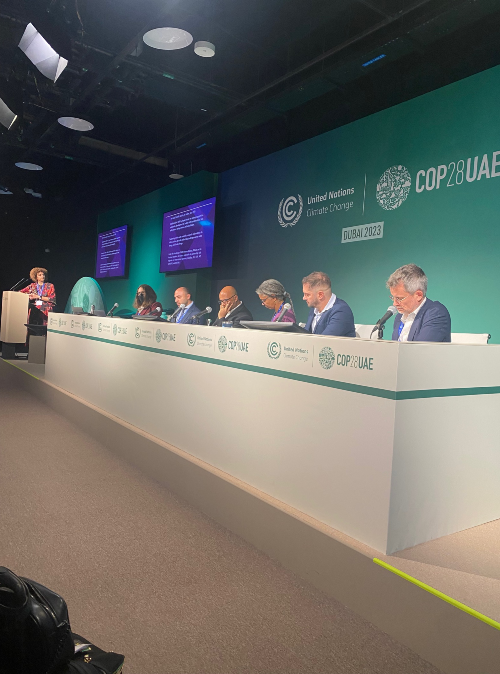How climate change has impacted agriculture in sub-Saharan Africa
Lauren Thamert, a student at the College of St. Benedict and St. John's University, spoke with residents of sub-Saharan African at COP28 about the effects climate change has had on agriculture.

This piece is part of Project Optimist's student and community reporting program in central Minnesota. A group of students conducted field reporting at the COP28 conference in Dubai and wrote stories that highlight their research. Lauren Thamert is a sophomore at the College of St. Benedict and St. John’s University with a major in biochemistry and a minor in climate studies.
Africa as a continent is vulnerable to the climate crisis due to the economic status of many countries and the importance that agriculture plays into their economies. To make sub-Saharan Africa more resilient and to combat the effects of climate change, smallholder farmers and experts are looking for ways to adapt farming practices.
Africa is growing three times faster than the rest of the world and it will be home to a third of the world’s population by the end of the century.
The Food and Agriculture Organization (FOA) states that out of the 626 million people of sub-Saharan Africa (SSA), 384 million rely on agriculture for their primary income. Among those who rely on agriculture, 60% are smallholder farmers. In Nigeria alone, there are less than 100 farms larger than 124 acres.
Africa was at the center of the conversation at the United Nations Framework Convention on Climate Changes (UNFCCC) 28th Conference of the Parties (COP) in Dubai around the future of agriculture, even though each SSA nation’s pavilion and representatives expressed different goals and methods to pursue climate smart agriculture and crop resiliency.
During an interview at COP28, Dr. David Olufemi Awolala from Nigeria’s Department of Agriculture and Resource Economics identified deforestation prevention as the most beneficial adaptation practice in the region. Flooding is a severe problem in many parts of Nigeria; therefore, preserving the forest is more efficient in increasing crop resiliency than clearing land to overcompensate for the yield loss.
Addisu Negash from the Ethiopian Ministry of Agriculture identified drought-tolerant species and crop management measures as key pieces of the country’s long-term development strategy.

This was the first year that there was a thematic day dedicated to food and agriculture at COP which allowed Indigenous and underrepresented voices to be heard. The day gave a spotlight to underrepresented smallholder farmers to share their personal struggles and stories with climate change and its effect on agriculture. For example, Negash’s family in Ethiopia has struggled with water availability and groundwater scarcity for years on their sorghum farm.
Negash’s family, like many others, rely on the Ministry of Agriculture or other small governmental structures for information. However, when asked about the local perception of climate change, he said farmers are turning to an alternative information source: “To investigate the weather, they (farmers) are using the stars.”
Ethiopian farmers observe the sky at midnight, the arrangements of stars, and the wind conditions during the day to predict growing conditions for the coming year. What they’re seeing in the stars is confirmed by the growing conditions they witness, Negash said.
Compared to the increasingly industrialized agriculture systems of the Global North, the scale of SSA agriculture is far underdeveloped, which experts say makes SSA even more vulnerable to climate change and its cascade of effects. The risk of food production from crops, livestock, and fisheries together are driven by increasing temperature, heat waves, precipitation changes, drought, and increases in CO₂ concentrations.
While it is the duty of the Global North to take action to make up for their contributions to climate change, according to the UNFCCC, countries in sub-Saharan Africa require assistance from multiple sources to survive, adapt, and grow through these climatic changes.
The staple crops in SSA are wheat, rice, and maize. Experts say in order to protect yield and quality of crops in SSA, the plants and their farmers need to adapt to the different stressors of climate change, which can be broken down into two sections: changing how crops are grown and the increasing use of biotechnology.

Various shifts in how crops are grown, such as crop diversification, planting management, cultivation differentiation, and fertilization rates, can increase crop resiliency and are common practices in the Global North. Practices are different from country to country, region to region, year to year, and farm to farm.
Agriculture diversification is used to cope with yield loss by spreading risk and therefore minimizing vulnerability in small farms. Simple changes such as adjusting planting times, locations, or crop types/variety can make a difference.
Crop rotation helps control pest outbreaks, which is critical to protecting yields as half of the farmers in west Africa surveyed by the International Panel on Climate Change perceive increases in crop pests and diseases as due to climate change. Their observations are supported by the 2022 edition of the IPCC report which found 10%-35% yield losses for cash crops in sub-Saharan Africa.
Seed and germplasm breeding programs are a luxury in SSA. Drought-tolerant seeds are increasingly effective in Africa but do not address climate changes in all regions, Dr. Awolala said. These breeding programs are especially impactful when a resilient breed can be created quickly after a stressor is identified or even more impactful when the resilient breed is available before nutrition or yield loss happens. Seed breeding research is most directed towards drought tolerance and maize.
Research confirms there are promising pathways to increasing SSA crop resiliency, but feasibility depends on how the global community allocates and advocates for support and a spot at the table for smallholder farmers.
